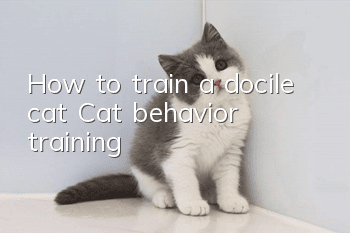The function and care of cat claws

Claws are a cat’s sharp weapon. Once a cat is attacked or has the intention of actively attacking, it will show its bright claws as a demonstration to scare people and other animals. Now domestic cats have been domesticated and cared for. The claws are not as sharp as they used to be, but you are still lucky enough to see the power of some cats’ claws on some furniture or on the owners.
Should cats be declawed?
In the past 10 years, data from the United States and Canada show that many cat owners have their cats’ toenails removed by professional veterinarians. The main reason behind the popularity of toe removal is that more and more pet cats in cities are domesticated indoors by owners who are aware of "luxury furniture". Therefore, it is essential for cats to undergo this basic declawing service in order to live in their owner's well-appointed home. This process is done to prevent cats from scratching "valuable" furniture. However, toe removal has only been developed for 30 years. Cats with claws have lived indoors much longer than that.
Decedication removes the cat’s bones, tendons, ligaments, and the first knuckle at the tip of each claw. Toe removal removes a vital part of the cat's body and is the most important part of the cat's anatomy. Simply put, a declawed cat is a disabled cat.
Putting aside the physical pain caused by toe removal, it also has a huge psychological impact on cats, which completely makes them lose the ability to climb, chase, hunt and socialize with cats.
According to a 1994 veterinary clinic scientific report from Washington State University, 50% of the 163 cats that were dedigitized suffered one or more complications immediately after the surgery, such as pain, bleeding, disability, Symptoms such as weight loss. Further follow-up of 121 cats after surgery showed that 20% developed ongoing complications, such as infection, sudden weight gain, protruding bones on the claws, intermittent lameness (abnormal walking posture), etc.
Just to prevent the cat from scratching the furniture and scratching people, all the cat's claws were cut off... It saved people's worries, but the cat was useless. You should know that cats use their claws during friendly or unfriendly social interactions with others, when running and climbing, when hunting and in self-defense. It can be said that a cat without claws has no cat characteristics except that it can "meow".
The main functions of a cat’s claws are as follows:
1. Cleaning:
A smooth, clean coat is essential to a cat’s health and happiness. Temperature control, cleanliness, waterproofing and maintaining the body's breath signals are vital to cats. Research shows cats spend a lot of time grooming themselves every dayPut on makeup. Not only the typical licking motion, but also repeated scratching. This scratching motion is a key part of your daily cleaning routine: getting rid of itchy skin, removing shed hair and combing out stray body hair. Without claws, neither humans nor cats can scratch themselves effectively. The whole sorting process will be very painful. Even if the owner grooms them every day, it cannot replace the pleasure that natural scratching brings to them. Anyone who has an itch that they can't scratch (or can't reach the itchy area) can relate to the awkwardness of a declawed cat.
2. Climbing:
Climbing is the second instinct of cats. In fact, no matter how much you punish it, it will never stop its desire to climb. If it still tries to climb after the digits are removed, it will be the biggest punishment in its life, because it will no longer be able to grab anything with its claws and toenails. If it runs outdoors, it will be more dangerous. If it is chased by other cats, dogs or hostile people, at the first opportunity, it will quickly run away to higher ground to avoid the enemy's attack. When it jumps up onto a wall, fence, or tree, it uses its claws that no longer exist to grip the surface. It's too scary for it, and it will find itself sliding downwards and finally falling in front of its enemy.
3. Defense:
When facing an enemy, when it needs to protect itself, it will be in a very disadvantageous situation. As it swung its claws, it had lost its defensive weapons. Usually, just the pain caused by those tiny sharp claws can make it hover on the edge of life and death.
4. Hunting:
Not only does it destroy the cat’s ability to clean, climb, and defend itself, dedigitation also destroys the cat’s ability to hunt. "Ah," you might say, "that doesn't matter to my cat; he's a well-raised family pet." However, this well-raised cat will one day get lost on the street or become homeless. When he returned, he quickly died of hunger. For predators with sharp claws, the necessary grasping action will become a useless gesture.
How to trim and care for cat claws:
Between declawing and random scratching, most owners will trim their cat’s toenails regularly. This is a very simple matter if you start the cat from an early age, although most cats will eventually tolerate this procedure.
Special tools can be purchased at pet stores. Find the right tools (don't use human nail clippers, which can crush or injure your cat's claws if you're not careful), and the sharper the blade, the easier the process will be. It was a blade with a short hook. This might make it easier for people to get started.
Secure the cat in your armsInside, or on your lap, maybe anchoring it to the floor with your legs, depending on the size of your cat and you. Use the crook of your arm to pin the cat down to the ground so it can't move, and grab its paws with your hands (sometimes it will escape from under your arms, so it takes more practice). Keep its back facing you so it can't catch you or run away easily. Use your skilled hands to hold the nail clippers. Squeeze the cat's paws with your hands and the toenails will be exposed.
Examine them carefully (you must do this to familiarize yourself with the structure of its claws before actually trimming them). If the paws are white (most cats are), the nails and flesh are easily identifiable (with good lighting, of course). You can see that the tender flesh under the toenail is pink, at the base of the toenail. The attached skin under the toenail and the growth behind it are very easy to identify. Be sure not to cut into the tender meat underneath.
Your cat will be in extreme pain and will be covered in blood. When in doubt, cut as little as possible. Of course this means regular pruning.
Trim each toenail on the tender flesh, don't forget the "thumb". For cats, the "thumb" is only on the front paw, equivalent to a human thumb, and they never touch the ground. Some cats are polydactyl, with up to seven toes on one paw. There are usually four toenails on each paw, and a "thumb" on each front paw.
Hind claws do not need to be trimmed often or at all; they do not grow quickly and are not as sharp. You must hold down one of the four claws; it will get easier with practice. If you still can't control your cat, it's best to ask someone for help. Then you can pick up its paws and finish.
Declawing is a selfish choice made by irresponsible owners, and some European countries have outlawed the procedure as illegal animal cruelty. Therefore, for people who really love cats, scratching posts, love and patience are the keys. From the time the cat is young, just take it to the scratching post as soon as it scratches the furniture. If you repeat it patiently a few times, the cat will understand the owner's intention and usually will not scratch the furniture again. In addition, understanding your cat's temperament and regularly manicuring your cat's nails will also make you and your cat happy. Or if your cat is really naughty and mischievous, try wearing plastic nail covers for your cat. As long as they are replaced every few months, the cat can keep its own nails without damaging anything in the house.
- What is the personality of American Shorthair cats?
- Are Siamese cats easy to raise? Siamese cat personality
- How to keep cats off sofas and beds?
- Why does Garfield always cry?
- What are the symptoms if a kitten accidentally eats cat litter?
- Cat vomits after eating
- Is catnip, which cats love so much, harmful?
- Does a female cat need extra nutrition during pregnancy? Cat feeding!
- How to make a cat smart and obedient
- What should I do if my cat eats oil?



